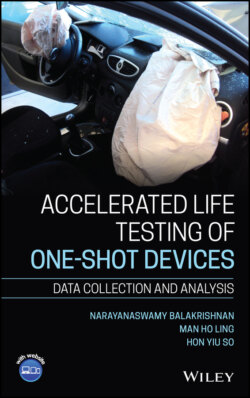Читать книгу Accelerated Life Testing of One-shot Devices - Narayanaswamy Balakrishnan - Страница 22
1.5 Recent Developments in One‐Shot Device Testing Analysis
ОглавлениеWe now provide a brief review of some recent developments on one‐shot device testing data analyses under ALTs. For CSALTs, Fan et al. (2009) compared three different prior distributions in the Bayesian approach for making predictions on the reliability at a mission time and the mean lifetime of electro‐explosive devices under normal operating conditions. In a series of papers, Balakrishnan and Ling (2012a,b, 2013, 2014a) developed expectation‐maximization (EM) algorithms for the maximum likelihood estimation of model parameters based on one‐shot device testing data under exponential, Weibull and gamma lifetime distributions. In addition to parameter estimation, different methods of confidence intervals for the mean lifetime and the reliability at a mission time under normal operating conditions have also been discussed by these authors. The maximum likelihood estimation as well as associated tests of hypotheses, though are most efficient when the assumed model is indeed the true model, are known to be non‐robust when the assumed model is violated, for example, by the presence of some outlying values in the data. With this in mind, weighted minimum density power divergence estimators have recently been developed for one‐shot device testing data under exponential, Weibull, and gamma distributions (Balakrishnan et al., 2019a,b, 2020a,b).
Some other important inferential aspects, apart from the works on the estimation of model parameters and hypothesis tests described above, have also been addressed by a number of authors. Balakrishnan and Ling (2014b), for instance, have developed a procedure to obtain CSALT plans when there are budget constraints for testing one‐shot devices. Ling and Balakrishnan (2017) also studied model mis‐specification effects on one‐shot device testing data analyses between Weibull and gamma distributions, while Balakrishnan and Chimitova (2017) conducted comprehensive simulation studies to compare the performance of several goodness‐of‐fit tests for one‐shot device testing data.
In the framework of competing risks analysis, Balakrishnan et al. (2015, 2016a,b) discussed the analysis of one‐shot device testing data when the devices contain multiple components and hence having multiple failure modes. Another extension that has been provided for one‐shot device testing is by Ling et al. (2016) who have developed proportional hazards models for analyzing such data. Optimal SSALT plans for one‐shot device testing experiment with lifetimes following exponential and Weibull distributions have been discussed by Ling (2019) and Ling and Hu (2020).
Pan and Chu (2010) have investigated two‐ and three‐stage inspection schemes for assessing one‐shot devices in series systems of components having Weibull lifetime distributions. Finally, Cheng and Elsayed () have examined several approaches to measure the reliability of one‐shot devices with mixture of units under various scenarios and have presented reliability metrics of systems with mixtures of nonhomogeneous one‐shot units subject to thermal cyclic stresses and further optimal operational use of such systems.
In the chapters that follow, we shall elaborate on all these developments and also highlight their applications.
